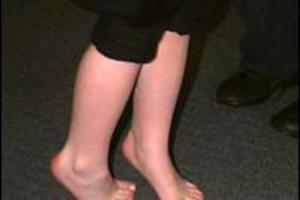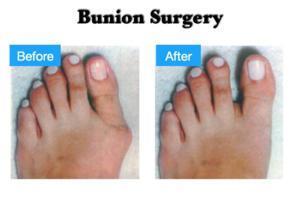![]() EXPERT
EXPERT
John Goodner
Podiatrist (Foot and Ankle Specialist) | Foot & Ankle Surgery
Voted Best Podiatrist in Pembroke Pines 2021, 2022 2023; Plantation 2022, 2023; Miramar 2023 by the readers of Our City Magazine ~ Pembroke Pines, Plantation, Miramar
Care Philosophy:
As a former athlete, there is nothing more rewarding than getting our patients back to the sports and activities they love. I comprehensively evaluate all injuries and conditions of the lower extremity. I evaluate gait and take xrays when necessary to complete the exam and provide an accurate diagnosis and efficient treatment plan that is well adapted to the patient's specific sport or activities. In most cases, conservative care is best. However, when necessary, surgery is offered if all conservative care options have failed. Before any procedure, all risks and benefits are always discussed. Our greatest asset is the team approach from our foot & ankle surgeons with 75 years of experience between them all. I am an advocate for my patients and readily give them my email address after our visit to answer any further questions or clarify our conversation. I encourage patients to visit our website, instagram @southfloridasportsmedicine, and twitter @SFLSportsMed for patient education.
- Plantation, Florida
- Memorial Healthcare System
- Accepting new patients
Increased Lower Extremity Fracture Risk with Osteoporosis
Very few adults at risk for advanced bone loss and fracture are participating in necessary testing to determine the extent of their bone density decline. With a large volume of...
My Child is Toe Walking, Should I Be Concerned?
In an UNCOMPENSATED PATIENT WITH TIGHT CALF MUSCLES the child or adult walks almost exclusively on their toes without the heel touching the ground. The foot does not compensate...
Does My Child Have Growing Pains or Merely Flatfeet? Parents Be Pro Active!
Foot, ankle and leg problems in the growing child are often considered to be “Growing Pains” in the bone and muscles of the lower extremity. While in a small number of cases this...
Bone Stress Injury and Female Athlete Triad
The female athlete triad can occur in any sport or exercise , most commonly in sports that emphasize a lean body build. Low energy availability can be accompanied by an eating...
What Can I Do About My Bunion?
1. What is this large bump on the inside of my foot? It is called a bunion. A bone is becoming more prominent on the inside of the foot. It is part of your normal foot and...
Advanced Treatment Options for Foot and Ankle Conditions
Advanced Treatment Options for Foot and Ankle ConditionsIf you've had a foot and ankle injury, that has lasted for several months, and has not gotten better despite rest and physical...
Athletic Injuries and Synthetic Playing Surfaces
Generations of advancing technology have provided the most durable and versatile artificial surfaces now installed at the professional, collegiate, and high school fields and arenas....
Common Lower Extremity Injuries for Runners
Many people will try out new exercise or running routines, however, if they are not careful there are many foot and ankle injuries they may suffer. It is recommended to increase...
What are the best surfaces to run on?
What are the best surfaces to run on? Dr. John Goodner Grass is superior as far as impact and muscle usage, however, many people do not have access to this type of running surface...
Benefits of Running with Orthotics
Benefits of Running with OrthoticsBy Dr. John GoodnerWhether you like to run 5K’s, 10K’s, Half or Full Marathons, having the proper running shoe is the single most important factor...
Injured foot?
Pain in the fifth metatarsal in an athletic person should often be evaluated relatively quickly after it is felt. Stress to the fifth metatarsal may weaken the bone, predisposing it to more simple trauma that can break the bone in an area with poor circulation. Initial x-rays may be necessary but if the clinical exam is consistent with an injury, MRIs may be necessary to further evaluate the injury. If MRLs do show that there is bone marrow edema then this injury should be treated with a period of immobilization to allow the area to heal. Failure to address this when it is in a pre-fracture stage may predispose the athlete to further injury.
If the x-ray does show that the bone has fractured in the region with poor circulation, conservative and surgical treatment options are offered. Conservative care includes a non weightbearing cast for eight weeks. A return to sports may be 3-4 months. There is a high risk of refracture to this area in athletes with a high arch foot. In those patients, surgical treatment may be performed initially to allow the fracture to heal more rapidly and return the athlete back to sporting activity. This would require non weightbearing for six weeks in a boot. Athletes can usually return to activity following the use of screw fixation in approximately 10-12 weeks. If the foot has an excessively high arched posture in which the heel bone is turned under, surgery in the rearfoot may also be necessary at the same time to get the heel bone straight and take the stress off of the outside of the foot. A procedure on the heel bone usually recovers more quickly than a procedure on the metatarsal.
Surgery when performed is done on an outpatient basis under a twilight anesthetic. An incision of approximately 1/4" is placed on the side of the foot. Through this incision, a small pin is placed into the bone. A screw is then applied over the pin to compress the fracture and allow it to heal more rapidly. The size of the screw depends on the size of the bone. We usually employ a 4.5 mm titanium screw in females. In athletic males who have much larger bone screws that are 5.5 mm to 7.0 mm may be necessary. In athletes, we prefer solid screws over partially threaded screws. We have had great long-term success in healing patients with these fractures. Patients are typically allowed to bathe 2-4 days after the procedure, as only one stitch is used. Although they are non weightbearing they can get into the gym very quickly and work their upper body. Leg extensions and leg curls can also be performed. We have found a period of non weightbearing for six weeks is typically best. However, x-rays and clinical exams are important to assess how the patients are healing. A return to walking in a boot is usually performed at week 7 or 8. If the fracture is healing as expected sneakers and an orthotic device in their shoes utilized in running can begin between 8 and 12 weeks depending on the clinical exam and x-rays. A return to active sports may take 10 or more weeks. We typically do not allow athletes to return sooner for fear of reinjury to the bone or fracturing the screw.
Jones fractures can often go on to delayed union. This means that the fracture is not healing in the expected time. In those cases, bone stimulators may be used to help accelerate the healing process. In some cases, this fracture may go on to a nonunion. Nonunions of the fifth metatarsal can become very painful and cause a disability in a running athlete. It will most often require surgery to remove the areas of the bone that are devoid of blood supply. A bone graft is then applied to the fracture and a small plate or screw is utilized to stabilize the fractured area. Nonweightbearing for 8-12 weeks would be mandatory. The long-term prognosis is excellent. If there is a foot deformity that predisposes the patient to increased stress to the fifth metatarsal, surgery would be necessary for these other areas to unload the fifth metatarsal more permanently.
My ankle is swollen?
Best course of action for month old toe injury?

Achilles question?
Can a doctor do anything for a broken toe?
Dependent on fracture type and severity; treatment options range from taping, splinting, offloading shoes/boots, closed reduction of the fracture with local anesthesia, percutaneous pinning, or open reduction internal fixation of toe fracture.
What type of sedation is used for toe surgery?
Is ankle ligament surgery painful?
How long does ankle ligament surgery take?
How do you help ankle arthritis?
Treatment options include:
Mild cases: Braces - ankle, and foot orthoses, (AFOs) may help to decrease motion in the ankle joint, lessening the pain.
Moderate cases: When a conservative case has not helped, arthroscopic surgery to remove the abnormal bone, soft tissue, and cartilage may be of benefit. If the disease process is advanced, only temporary benefits may be achieved.
Severe cases: When arthritis has advanced and has been unresponsive to conservative care and/or arthroscopy, a fusion of the ankle joint is the gold standard. During the fusion, the cartilage and the joint surface are completely removed. The bones are then put together and held in place with screws. This procedure can be performed arthroscopically if there is a minimal deformity to the foot and ankle. If there is severe deformity the procedure may be performed open.
The long-term outcome is excellent following the procedure with regards to eliminating the pain. Most patients can return to walking without discomfort.
Some cases of severe arthritis may be candidates for Total Ankle Replacement surgery. This is a technique where the ankle joint is replaced by a prosthetic (artificial) ankle.
Broken toe?
Rolled my ankle?
How long should I rest a sprained ankle?
Return to play is carefully determined by the Foot and Ankle Specialist based on the specifics of your sport or activity. Physical therapy is highly necessary for a full recovery and to minimize the recurrence of injury secondary to ankle instability. A gradual increase in activity is encouraged, usually at 10% increments per week. Low impact exercise usually begins once the ligaments appear clinically healed and proprioception is restored to the ankle joint. Sport specific rehabilitation can expedite the recovery of the patient and potentially lead to a faster return to play. Many patients and athletes may need an Ankle brace for several months after return to play is initiated.
Immediate care is necessary to prevent any long-term problems.
Mild injuries associated with minimal swelling may be treated with rest, ice, elevation and an ankle brace. 2-4 weeks for full recovery is typical.
Moderate injuries in which a partial tear has occurred may necessitate immobilization for 2-6 weeks in a removable boot or hard cast.
Severe injuries need to be immobilized in a hard fiberglass cast, or removable boot and brace combination, for 4-6 weeks to allow the ligaments to heal properly. Weight bearing is usually allowed. Sometimes these can take several months to fully recover depending on severity of injury.
Anti-inflammatories such as advil, ibuprofen, aleve, motrin or naprosyn should ALWAYS BE AVOIDED in the first 5-7 days of injury. Ligaments heal with accumulation of growth factors and scarring; these medications lessen inflammation which essentially reduces scarring. This is NOT a good thing to do. Acetominophen, Tylenol, is preferable for pain management, in addition to the Rest, Ice, Compression, Elevation protocols.
Physical therapy following bracing or cast removal is necessary to improve muscle strength, ankle stability, joint proprioception and to restore complete ankle range of motion. If left untreated, chronic instability commonly develops. Recurring twisting injuries then occur with minimal stress. This will require chronic use of an ankle brace and physical therapy. Prolotherapy can sometimes be performed to cause inflammation in an attempt to restore or increase stability. This is a series of weekly injections into the ankle ligaments, ultrasound guided with an irritant solution of Dextrose and Lidocaine (sugar water). Platelet Rich Plasma (PRP) injections may provide a stimulus to healing If there is chronic instability, surgery would be necessary to surgically reconstruct the ligaments in the ankle and allow a full return to activity. In such cases, the prognosis is excellent.
Is physical therapy good for an ankle injury?
Physical therapy is highly recommended to improve the long term prognosis and minimize risk of chronic ankle instability, ankle impingement syndrome, or ankle arthritis.
How long does it take to walk after heel fracture surgery?
Sedentary jobs can resume after one to three weeks. Work requiring extensive weightbearing may take six to twelve months. If the bone injury is severe, a change in a person’s job may be needed. Sports modifications will also be necessary.
Sedentary jobs will provide little problem for patients with calcaneal fractures. Work restrictions will be necessary for the person who has to weightbear. Walking long distances or standing for a period of time will adversely affect the foot. These restrictions may be in place for up to one year. In some cases these restrictions may be permanent.
How long does it take to walk after foot surgery?
What kind of anesthesia is used for ankle joint surgery?
Monitored anesthesia care with local anesthesia and Regional anesthesia are used for less invasive ankle joint surgery.














